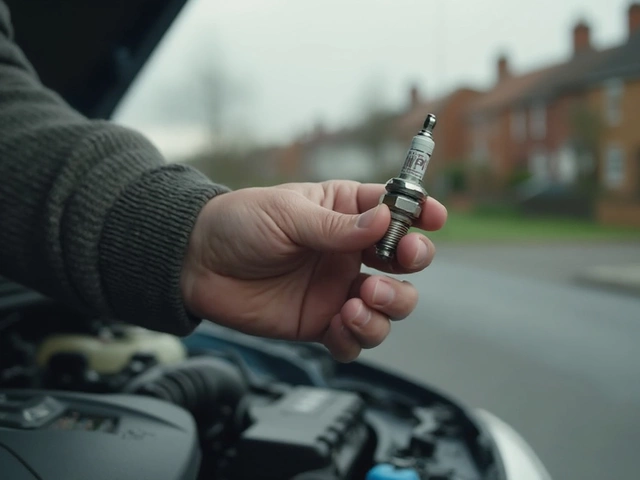Ever cranked your engine and heard it cough, sputter, and beg for mercy? Spark plugs can be that tiny part messing with your ride, yet most drivers ignore them until their car starts acting up. It’s not some wild guesswork either—bad spark plugs love to send out warnings if you know how to catch the signs. It's eye-opening how one cheap part can make or break your smooth drive, worst case even leave you stranded with a staring contest at your dashboard lights. Surprisingly, lots of folks swap plugs on a blind schedule rather than actually checking if they're still good, which is not just wasteful, it’s missing the whole point of car care. So, how can you really tell if that spark plug stuck in your engine is doing its job? Let’s break it down in plain English—no confusing jargon, just real, practical info you can use, even in your own driveway.
Main Signs Your Spark Plug Might Be Bad
You don’t have to be a certified mechanic to spot a bad spark plug. Your engine practically shouts for help in ways you feel instantly. The easiest one? A misfire. When a spark plug fails to ignite the air and fuel mixture, your engine stumbles, skips, or vibrates—not a soft, polite kind of shake, but the type you notice in the seat and steering wheel. Modern engines often have a check engine light that flashes for misfires, but even if your car’s too old for lights, you’ll notice it drinks gas like crazy, loses power, or sounds like it’s got a hiccup that won’t quit.
Bad spark plugs can also make cold starts an adventure—you know, that morning when the car seems to whine before giving in. Stalling or rough idle is another giveaway. Instead of a steady purr, your engine coughs or dips unpredictably at stoplights. One more obvious symptom? Reduced acceleration. Try pressing the gas for a quick merge or overtake, and you’ll feel your car hesitating, almost like it’s second-guessing itself. No rocket science here—it’s usually the spark plugs crying out for attention.
The funny thing is, these signs often get blamed on fuel, bad weather, or more complicated problems. But about 40% of mysterious engine issues in older cars, according to data from the Car Care Council, boil down to worn or fouled spark plugs. So, learning to sniff out these symptoms early can save you time, money, and more of those awkward sidewalk ‘hood up, phone out’ moments.
Here's a quick look at what you might experience if your spark plug is on its last leg:
- Slow or hard starting
- Rough idle and engine vibration
- Engine misfire (single cylinder or more)
- Poor fuel economy (noticeable drop in mileage)
- Laggy acceleration and loss of power
- Persistent check engine light that won’t go away
These symptoms can be sneaky—sometimes they show up one at a time, or all at once. If two or more are happening, it’s time to check your plugs.
Visual Inspection: Reading the Spark Plug’s Story
Pulling out a spark plug and looking it over is something anyone can do, even with basic tools. Start by letting the engine cool down. Use a spark plug socket and ratchet, carefully remove the plug wire, and pull the spark plug from the cylinder. Here’s where things get interesting—each spark plug tells a story about what’s happening in your engine. The color, residue, and even the smell can reveal how well your engine’s burning fuel and if a plug is toast or still good.
A healthy spark plug will be light gray or tan on the tip. This means the air-fuel mix and combustion are pretty spot-on. If it looks oily, you might have an oil leak in your combustion chamber. If you see dry, black sooty carbon, your engine is running too rich (too much fuel or too little air), often due to a dirty air filter or bad sensors. White, blistered tips? That’s heat damage, usually caused by running too lean (not enough fuel, or maybe a vacuum leak). Seeing a green, powdery residue is rare but it can come from certain fuel additives or coolant leaks.
Cracks or chips on the insulator are a sure sign you should swap out that plug. If the center or ground electrode is melted or severely worn down, it can’t maintain a strong spark anymore. And if the threads are caked in oil or fuel, that’s a clear red flag for bigger issues than just the plug itself. You don’t need perfect eyes—just check for something abnormal, weird colors, deposits, or physical damage. Here’s a breakdown of what you might see, and what it really means:
- Tan or gray tip: All good, your plug’s still working fine.
- Sooty, black, dry:
- Running rich, bad air-fuel mix, clogged filter, or short-trip driving only.
- Oily:
- Oil control problems—think piston rings or valve seals, not the plug’s fault.
- White or blistered tip:
- Running lean, overheating, possible vacuum leak or timing issue.
- Cracked insulator or electrode:
- Replace immediately—risk of more misfires or engine damage.
The first time you check your own spark plugs, you’ll get a crash course in your engine’s real health. Your spark plugs don’t just live in your engine, they track its every mood swing and bad habit. Keep them for reference after you pull them—lining up an old and a new one side by side can show you a lot more than you’d think.

Testing Methods: Guaranteeing Spark Plug Health
Just looking isn’t always enough—sometimes a plug might look fine but still fail to spark. Here’s where testing comes in. First up, the simplest way is the spark test (sometimes called a spark plug bench test). Basically, you reconnect the plug wire to the plug, ground the threaded part of the plug against metal in the engine, and have someone turn the key briefly. You should see a bright, blue-white spark jump across the tip. Anything orange, weak, or no spark at all? The plug might be dead, or there’s a problem with the ignition coil or lead. Don’t get too close—high voltage loves to bite.
Beyond the backyard tricks, real garages use a spark plug tester tool. These tools let you check whether a plug will fire reliably under a simulated load, not just in open air. Some plug testers even pressurize the chamber, mimicking engine compression so you’ll know if a plug can handle real-world stress. You can buy an affordable, decent tester at any auto parts store. If you’re serious about accuracy, a multimeter test might tickle your inner nerd: check the plug’s resistance between the terminal and center electrode. Most spark plugs read between 4,000 and 8,000 ohms (check your car’s manual for the exact spec). Out-of-range resistance, especially if it reads infinity (open circuit), means it’s time for a new plug.
Gap measurement is another trick. Spark plugs are factory-gapped but don’t trust it blindly—especially on new plugs that might get banged around during shipping. Your owner’s manual will list the correct gap (usually between 0.028-0.060 inches). Use a gap gauge tool or feeler gauge and gently adjust the electrode with light pressure. Too tight and the spark can’t jump. Too wide and it gets too weak, especially at high RPMs. Plug gap makes a bigger difference than people think—studies show up to a 12% drop in fuel efficiency if the gap drifts too far from spec.
If you’re ever in doubt, swap in a new spark plug—even temporarily. If your misfire, hesitation, or weird idle vanishes, the old plug was the real troublemaker. Simple, cheap, and effective.
| Testing Method | What It Checks | Tools Needed |
|---|---|---|
| Visual Inspection | Residue, wear, heat damage | Spark plug socket, flashlight |
| Spark Test | Ignition strength and color | Helper (or remote starter), gloves |
| Plug Tester | Spark reliability under load | Bench tester tool |
| Gap Measurement | Gap wear/drift | Feeler or gap gauge |
| Resistance Check | Internal continuity | Multimeter |
Best Tips for Spark Plug Maintenance and Troubleshooting
Spark plugs aren’t high maintenance, but regular checks make a difference. Even if your car manual says plugs last 60,000 or 100,000 miles, don’t let them sit and forget it. Quick inspections every oil change—just pop out one or two for a look—can catch problems early. If you notice odd wear, melted or cracked tips, or thick deposits, deal with it right away. Swapping plugs as a set is smart since they wear together, and mixing old and new can sometimes cause slight balance issues in modern engines.
Keep those plug threads and seats clean. Use a little anti-seize compound if your engine manual recommends it, but not too much. Over-torquing or cross-threading plugs is a classic DIY mistake. Always start threading by hand, and tighten by feel or with a torque wrench to the spec (usually around 18-25 ft-lbs for most plugs). Too tight can crack the ceramic, too loose and they can blow out when the engine heats up. Get this step right, and your spark plugs will seal better and last their full lifespan.
Pick the right type for your engine. Not all spark plugs are created equal. Standard copper core, platinum, and iridium plugs are all built for different uses, temperatures, and lifespans. If you have a turbocharged or performance engine, using a hotter or colder plug than stock could damage your engine or cause a misfire. Always stick with the heat range and design set out by your automaker. Turbo or high-compression engines are especially picky about plug design and tip shape, so don’t guess.
While you’re checking plugs, peep at the plug wires or ignition coils. Bad wires or failing coil packs can look just like a bad spark plug symptom wise. If the plug tip is light gray but your car’s still misfiring, the problem may be upstream from the plug itself. Checking and replacing ignition boots, wires, and coils can be the fix you never expected.
And here’s the kicker—modern engines can hide plug wear with management electronics, adjusting timing to cover small problems. You might not even notice a bad plug until it’s badly fouled or cracked. A quick plug inspection takes less than 10 minutes, while a neglected plug can tank your fuel economy, damage your catalytic converter, or melt down your ignition coils (three issues far pricier than any plug replacement).
If you want your engine running like new, give those spark plugs some attention. They're cheap insurance for avoiding roadside headaches, spent fuel, and engine trouble. Listen for misfires, watch for weird starts, and don’t brush off random dashboard lights. The heart of your engine relies on a spark—make sure it’s a good one every time.






